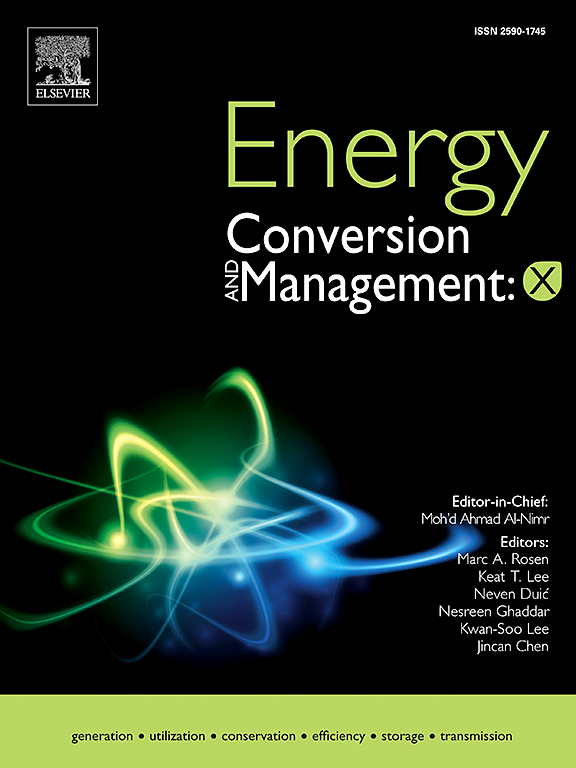A long-term energy transition planning model for a district heating and cooling sector incorporating sector coupling approach: A case study of the Czech district heating and cooling sector
IF 10.9
1区 工程技术
Q1 ENERGY & FUELS
引用次数: 0
Abstract
The decarbonisation of the district heating and cooling sector is a key component of Europe’s path to climate neutrality, particularly in countries with coal-dominated heat generation. This study addresses the challenge of planning the optimal transformation of the sector under multiple technical, environmental, and policy constraints. A novel linear programming-based optimisation model is proposed, combining national-scale planning with comprehensive coverage of technologies and fuels, binding legislative targets, and an explicit representation of sector coupling between the district heating and cooling sector and the power sector. This modelling approach makes it possible to explore whether flexible sector coupling technologies can effectively support both heat sector decarbonisation and electricity system flexibility under realistic policy and technical conditions, while remaining cost-effective. The model is applied to the Czech Republic as a representative case of a fossil-fuel-dependent country. Results show that by 2030, approximately 5 562 MWt of gas-fired combined heat and power capacity is expected to be developed, covering 51% of total heat demand, contributing an additional 11 TWh of electricity to the day-ahead market, and quadrupling the volume of balancing reserves provided compared to 2025. The results highlight risks of rapid scale-up, especially regarding permitting, investment, and supply chain conditions. Power-to-Heat technologies contribute by increasing electricity consumption on the day-ahead market by 1.9 TWh and quadrupling the volume of balancing reserves provided by 2050, while satisfying 4.3 TWht of heat demand. The results confirm that flexible sector coupling technologies form the backbone of the most economically efficient transition pathway.
结合部门耦合方法的区域供热和制冷部门的长期能源转型规划模型:捷克区域供热和制冷部门的案例研究
区域供热和供冷行业的脱碳是欧洲实现气候中和之路的关键组成部分,尤其是在以煤为主的供热国家。本研究解决了在多种技术、环境和政策约束下规划该部门最优转型的挑战。提出了一种新的基于线性规划的优化模型,将国家规模的规划与技术和燃料的全面覆盖、具有约束力的立法目标以及区域供热和制冷部门与电力部门之间的部门耦合的明确表示相结合。这种建模方法可以探索灵活的部门耦合技术是否可以在现实政策和技术条件下有效地支持供热部门脱碳和电力系统灵活性,同时保持成本效益。该模型适用于捷克共和国作为依赖化石燃料的国家的代表性案例。结果表明,到2030年,预计将开发约5562兆瓦特的燃气热电联产能力,覆盖总热需求的51%,为日前市场额外贡献11太瓦时的电力,与2025年相比,提供的平衡储备量增加了四倍。研究结果强调了快速扩张的风险,特别是在许可、投资和供应链条件方面。热电联产技术的贡献在于,到2050年,将使日前市场的用电量增加1.9太瓦时,并使平衡储备量增加四倍,同时满足4.3太瓦时的热需求。研究结果证实,柔性部门耦合技术构成了最具经济效益的转型路径的支柱。
本文章由计算机程序翻译,如有差异,请以英文原文为准。
求助全文
约1分钟内获得全文
求助全文
来源期刊

Energy Conversion and Management
工程技术-力学
CiteScore
19.00
自引率
11.50%
发文量
1304
审稿时长
17 days
期刊介绍:
The journal Energy Conversion and Management provides a forum for publishing original contributions and comprehensive technical review articles of interdisciplinary and original research on all important energy topics.
The topics considered include energy generation, utilization, conversion, storage, transmission, conservation, management and sustainability. These topics typically involve various types of energy such as mechanical, thermal, nuclear, chemical, electromagnetic, magnetic and electric. These energy types cover all known energy resources, including renewable resources (e.g., solar, bio, hydro, wind, geothermal and ocean energy), fossil fuels and nuclear resources.
 求助内容:
求助内容: 应助结果提醒方式:
应助结果提醒方式:


